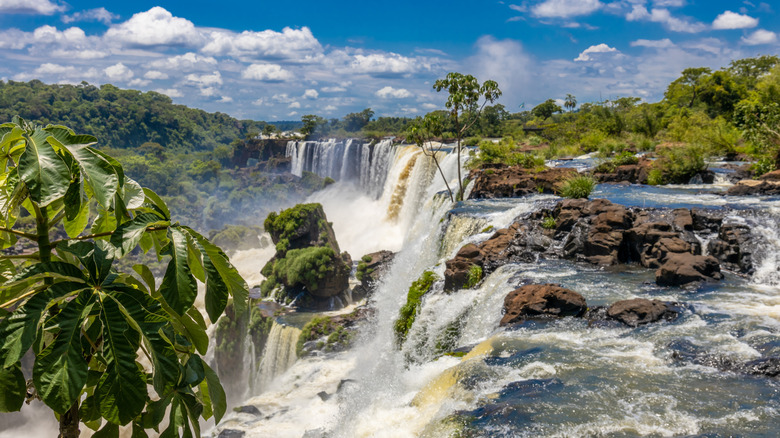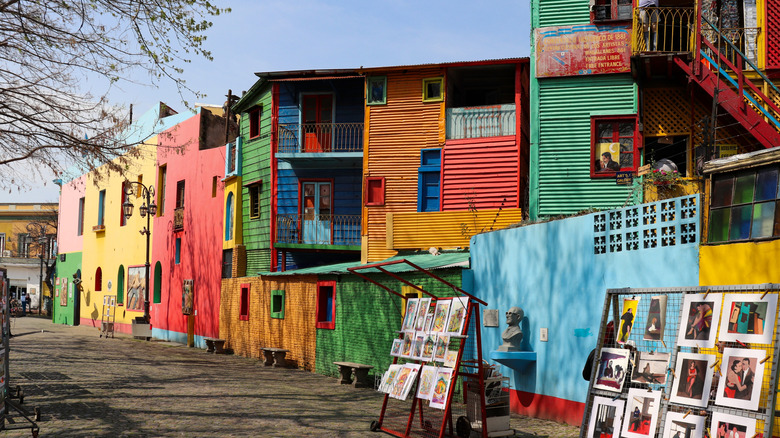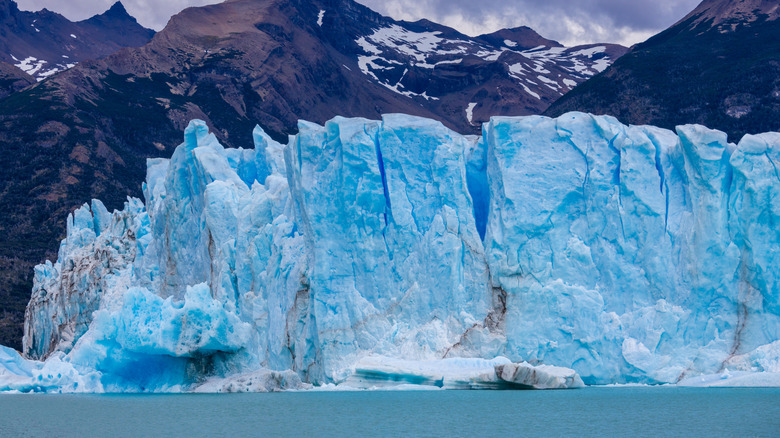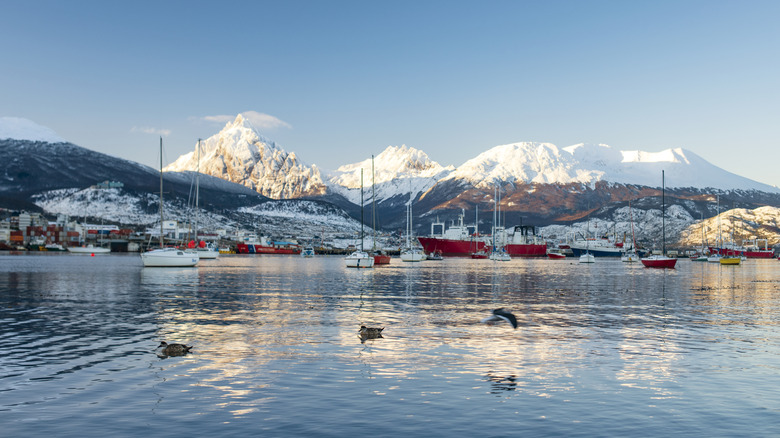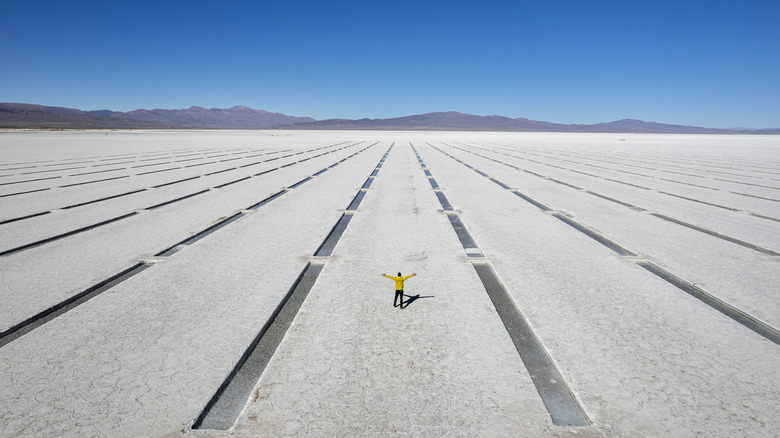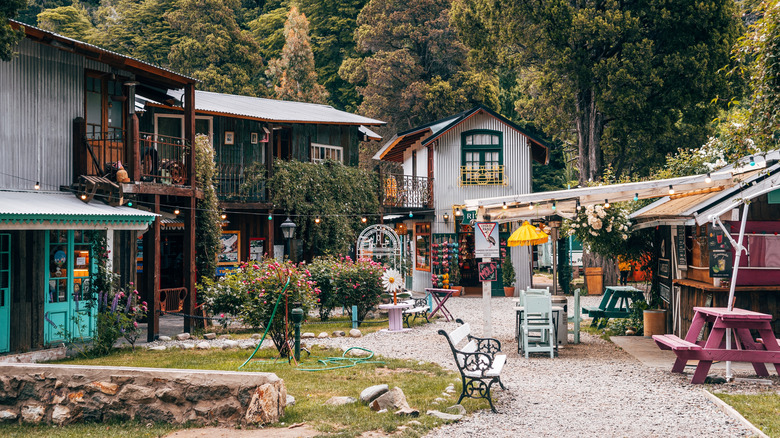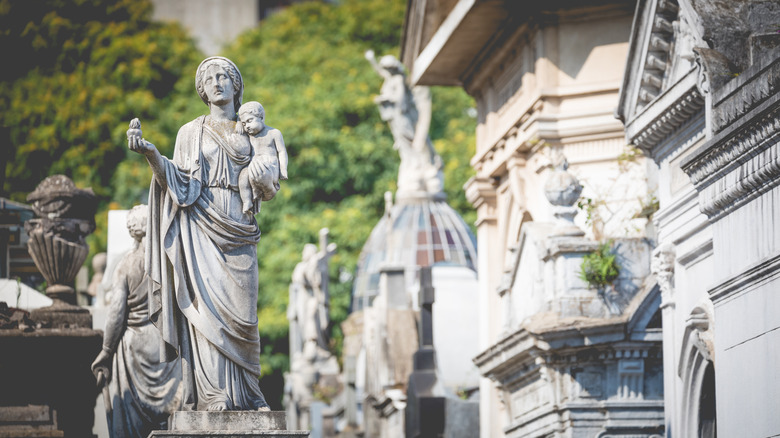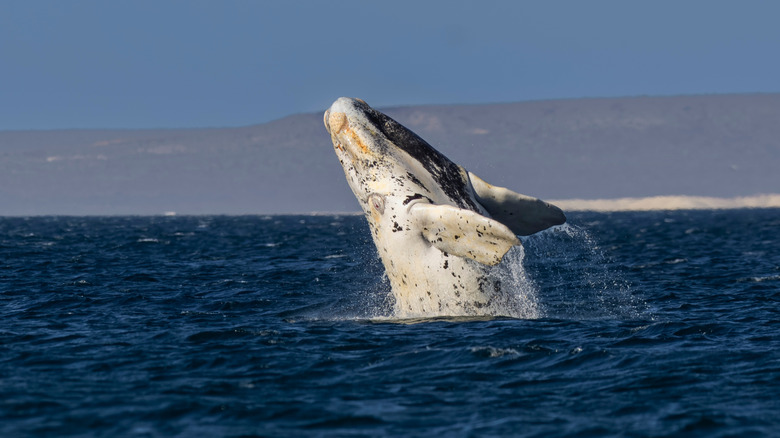Argentina's 10 Major Tourist Attractions To Add To Your Itinerary
From incredible waterfalls in tropical rainforests to icy regions that serve as the gateway to Antarctica, Argentina is a nation that almost contains entire worlds within its borders. Offering destinations and experiences like the jungle near Iguazú Falls, the plains of Patagonia, the urban culture of Buenos Aires, and the vineyards of Mendoza, this South American country invites travelers to soak up nature, culture, and adventure on a grand scale. Whether you're a first-time tourist or you're returning to Argentina for the tenth time, there are certain places throughout the nation you need to see at least once in your life if you haven't already checked them off of your bucket list.
As you read this guide, we'll take a trip through 10 must-see destinations that will allow you to enjoy every facet of Argentina's widely varied beauty. We'll explore cities, hike to waterfalls, and even journey to the end of the world. No matter how you like to travel, there's something in this round-up that will pique your interest in the eighth-largest country in the world. By the time we reach the end, you'll see why Argentina promises a travel experience that will stay with you for many years to come.
Iguazú Falls
Located on the border between Argentina and Brazil, Iguazú Falls has been astounding visitors for decades. Eleanor Roosevelt is said to have uttered, "My poor Niagara," upon seeing this incredible network of waterfalls for the first time. Made up of 275 waterfall cascades that are situated one right after the other over a span of nearly two miles, this is the largest waterfall system in the world, and a sight that is almost certain to leave you humbled by the sheer power of nature. The Iguazú Falls National Park area is actually comprised of two different parks — one on the Brazil side and one on the Argentina side — though Argentina has about 80% of the waterfalls.
Travelers can experience the wonder of Iguazú Falls up close via a network of bridges and walkways. On the Argentinian side, the main paths are referred to as the Upper Circuit and the Lower Circuit. The Lower Circuit allows you to walk closer to the falls than its higher counterpart. You will probably get wet if you choose this route! The Upper Circuit, however, affords the opportunity to take gorgeous aerial photos of the landscape. Perhaps the most popular vantage point of all, though, is the top of the Garganta del Diablo ("Devil's Throat") trail. At 269 feet tall and 492 feet wide, this is Iguazú's most dramatic offering. If you happen to be traveling during a full moon, take advantage of the otherworldly full moon walking tour offered by park authorities.
La Boca and Caminito Street (Buenos Aires)
Often referred to as "the Europe of South America," Buenos Aires is known more for its grand boulevards and Parisian vibe than anything else. La Boca, though, flips the script. This is a colorful Buenos Aires neighborhood where travelers can experience Argentina's soul. As the birthplace of tango, this historic district offers an authentic look at local life. The story of why the neighborhood is so much more colorful than anywhere else in the city is a fascinating one. Its most famous street, Caminito, is lined with colorful "conventillos," former tenement housing that was once inhabited by underpaid harbor workers who painted their homes with cheap, left-over paint, leading to an array of colors that still exist today. Regardless of their socioeconomic status, though, the people here — then and now — celebrate Argentine art, culture, and dance every day.
You'll be able to shop at local artists' stalls for souvenirs, and enjoy Argentinian folk dances and tango performances quite literally on nearly every street corner. There are also large-scale murals that mirror the colors of the local houses and shops. These make for fantastic photo ops! If you want to linger in La Boca, grab a cocktail and a bite to eat at Encuentro Nativo or El Gran Paraíso, the latter of which is housed in a converted conventillo. For a deeper dive into the city's heritage, check out the nearby San Telmo district, which is home to many of Buenos Aires' historic mansions, cobblestone streets, and a huge weekly Sunday antique fair.
Perito Moreno Glacier (Patagonia, Santa Cruz Province)
The Perito Moreno Glacier is the centerpiece of Argentina's Los Glaciares National Park. It is one of the most awe-inspiring sights in all of South America. Unlike most glaciers around the world, which are melting due to climate change, Perito Moreno is still active. As it advances, the ice sheet blocks the channel into Lake Argentina, creating cracks in the ice. Chunks of the glacier then loudly crash into the water; this is a famous feature of Perito Moreno. In addition to its main attraction, the South Patagonian Ice Field is home to other glaciers, such as Upsala and Onelli. Visitors can experience this area in several ways, all of which will make for unforgettable memories.
Adventurous travelers may want to embark on a guided ice trek. The two- to three-hour adult excursions may sound quite daunting, but are manageable even for those who don't work out regularly. There are also mini ice hikes available for families with children aged 10 and over. Visitors who don't want to climb on the ice but are still interested in hiking should visit the observation decks throughout Los Glaciares National Park. Among the most popular perspectives is the panoramic view from a large boardwalk-style viewing area. This is one of the most breathtaking places to experience Perito Moreno. For people who prefer to see the glacier in all its glory from a distance, luxury boat tours are a great option. Typically, passengers are able to see the ice breakage, or calving, that occurs about every 30 minutes.
Aconcagua (Mendoza Province)
Aconcagua is the highest mountain in the Western Hemisphere and one of the Seven Summits, the tallest peaks on each continent. The mountain is an astounding 22,829 feet tall and is truly a dream destination for climbers and adventurers from all over the world. Located in Aconcagua Provincial Park in Argentina's Mendoza Province, the Andes' greatest spectacle offers a variety of once-in–a-lifetime experiences, even for those who are not aiming to reach the top. For seasoned mountaineers, of course, the summit is almost always the goal. For these travelers, there are multi-day expeditions to the peak that last as many as 20 days. The trek is a test of endurance and skill, and requires serious planning. One of the lesser-known facts about Aconcagua is that it can be quite windy, so climbers are advised to pack warm, wind-resistant clothing and shoes.
However, you certainly don't need to be a professional climber to appreciate Aconcagua's beauty. Many people participate in day hikes to popular lookouts like the Plaza Francia Viewpoint and the Horcones Viewpoint. Plaza Francia, in particular, offers a gorgeous view of the south wall of the mountain and the surrounding Andes peaks. Horcones, meanwhile, is part of the larger (and quite difficult) Aconcagua Trek, but can also be hiked as a standalone trail. Visitors can also go rafting on the Mendoza River and spot wildlife. The best time to visit Aconcagua Provincial Park is during the climbing season, which spans from November to March.
Mendoza Wine Region (Mendoza Province)
Famous worldwide for its rich, red Malbec wines and picturesque landscapes, Mendoza is Argentina's premier destination for wineries. The area is home to over three-quarters of the nation's vineyards and is ranked among the top-producing wine regions on Earth. Whether you're a casual wine drinker or a devoted oenophile, Mendoza offers delicious flavors, stunning scenery, and culture in droves. Traveling along the Malbec Trail is one of the best ways to experience this area. It's dotted with vineyards from small family-run estates to international brands. The Trail is comprised of three distinct sections, each with its own attributes.
In Luján de Cuyo, travelers will find many of the most traditional Malbec winemakers in Argentina. Maipú is home to historic vineyards, as well as olive oil estates like Olivicolo Laur. Then, in Uco Valley, vacationers will find Argentina's more contemporary wineries, many of which use modern distilling practices. Must-see vineyards include Catena Zapata, which is modeled after a Mayan pyramid; Bodega Norton, one of Argentina's most storied estates that began in 1895; and Trapiche, which is known for turning some traditional techniques upside down to produce innovative wines. It also has a bar that was once a freight train! If you want to spend a weekend or longer in Mendoza, you'll find some of the world's most luxurious hotel pools here. Consider a stay at the immersive Entre Cielos Wine & Wellness Hotel or the classic Park Hyatt Mendoza.
Ushuaia (The End of the World)
Known as "Fin del Mundo," the End of the World, Ushuaia is the southernmost city on Earth and one of Argentina's most fascinating destinations. Situated between the Martial Mountains and the icy Beagle Channel, this remote frontier town is known as the gateway to Antarctica. Visiting this spot is also an incredible adventure in its own right. While the city was founded by missionaries in 1884, Ushuaia's isolated location made it uniquely suited for another purpose: a penal colony. Soon, the city housed the country's most notorious convicts, a history that can still be explored by tourists today. Check out Museo Marítimo and Museo del Presidio, which are housed in the former national prison, built by convicts. Another structure that employed penal labor is the Iglesia de la Merced church, which is worth a stop for those interested in religious history and historic architecture. Around the city are murals depicting prisoners, serving as a reminder of the city's nefarious past.
The main reason to visit Ushuaia, though, is the outdoors. In the lush and rugged Tierra del Fuego National Park, travelers will find glacial lakes, forests, waterfalls, and coastline, all with the Andes Mountains in the background. One of the park's most popular activities is the End of the World Train, which once carried prisoners in Ushuaia and the surrounding area. Nowadays, it transports guests on this historic route 365 days per year. For an unforgettable experience at the far reaches of the globe, book a boat tour along the Beagle Channel. From this vantage point, passengers can see the famous Les Eclaireurs Lighthouse, colonies of penguins, and sea lions along the shore. Additionally, since Ushuaia is the port city for many Antarctic cruises, there are always interesting, adventurous people to meet.
Salinas Grandes (Jujuy and Salta Provinces)
Those who journey to the high-altitude plains of the Jujuy province and Santa province will be rewarded with the Salinas Grandes. These are Argentina's incredible salt flats, which seemingly stretch on forever. Though they are about half the size of Bolivia's famous salt flats, the Salinas Grandes still cover 2,300 square miles and have previously been ranked as one of the most wildly beautiful locales on Earth. Visitors can walk across the salt plains to take the area's signature photos, which often involve jumping, floating, or "holding" friends in their hands for the perfect photographic optical illusion.
However, the Salinas Grandes are more than an Instagram utopia. At night, this area is among Argentina's best stargazing destinations. Astrotourism is becoming increasingly popular in the country, and the Jujuy province's best spot is the Puna Region. For a luxurious experience in the Salinas Grandes, consider booking a glamorous, domed tent at Pristine Camp. While locals still harvest salt in the flats using methods that were developed generations ago, you don't have to worry about disrupting their way of life when you stay here. The resort is immensely eco-conscious and is built in a section that isn't being used for active salt harvesting.
Bariloche and the Seven Lakes Route (Río Negro Province)
The architecture and setting of Argentina's San Carlos de Bariloche feel more like a scene from the Swiss Alps than a city in South America. Sometimes called "Little Switzerland," this town offers chocolate shops, snow-capped mountains, and fairytale scenery. Though it is famous for its skiing, Bariloche's European flair makes it a year-round destination. In winter, local ski resorts do big business. Among the most popular options are Winter Park and Catedral Alta Patagonia, known for its proximity to some of the best slopes in the Southern Hemisphere at Cerro Catedral. When the snow melts, hikers, kayakers, and cyclists come out to play all season long. Nahuel Huapi National Park is a great destination for outdoor enthusiasts.
No trip to Bariloche would be complete without driving the Route of the Seven Lakes. This scenic roadway begins in Bariloche and offers many must-do experiences, including hiking at Llao-Llao Peninsula, checking out the El Cerro Tronador volcano, and exploring Colonia Suiza, another Alpine-inspired village. Then, there's the chocolate. Like Switzerland, Bariloche is known for its chocolate shops. Called chocolaterías here, the town is home to well over a dozen options. Chocolaterie, Rapanui, and Mamuschka are three of the best-reviewed spots. To stay in Bariloche overnight without breaking the bank, consider Selina Bariloche. For a more luxurious experience, check out the 1930s Llao Llao Hotel.
Recoleta Cemetery (Buenos Aires)
Eerie, elegant, and fascinating, Recoleta Cemetery is one of Buenos Aires' most iconic landmarks. Known for its immensely ornate mausoleums, this necropolis is as much an art museum as it is a graveyard. One of the most well-known artists featured here is Luis Perlotti, whose beautiful sculptures can also be found in Chacarita Cemetery. Antonin Mercié, Alfredo Bigatti, and Miguel Sansebastiano are among the other artists whose works can be seen here. This cemetery is the final resting place of many of Argentina's most prominent people, such as presidents, military heroes, poets, scientists, and socialites. If you venture out of the cemetery, you'll want to stroll through the uber-wealthy La Isla enclave to look at the mansions and parks, and drop by La Biela, a coffee shop that has been around since 1850 under various names. If you're an art lover, it's also worth perusing the Museo Nacional de Bellas Artes (the National Museum of Fine Art). The collection includes pieces by El Greco, Giovanni Battista Tiepolo, and Paul Klee.
One of the most visited tombs is that of Eva Perón (Evita), the legendary first lady whose life and legacy have lasted well beyond her 1952 death. Beloved by the working-class people in Argentina, Eva remained a public figure long after her husband's presidency ended. She has even had a major impact on pop culture in America, thanks to Andrew Lloyd Webber's "Evita" musical that was later adapted into a Madonna movie. Other notable graves in Recoleta Cemetery include those of Admiral William Brown, the Irishman who launched Argentina's navy; Rufina Cambaceres, the 19-year-old daughter of a writer, horrifically mistakenly buried alive; and Domingo Faustino Sarmiento, an Argentinian president who isone of the nation's most important historical figures.
Peninsula Valdés (Chubut Province)
On Argentina's Atlantic coast, Península Valdés is famed for its extraordinary biodiversity and natural beauty. This section of the Patagonian coastline is one of the best places in the world to get close-up views of marine wildlife. Depending on when you visit, you might see Magallanic penguins, elephant seals, flamingos, sea lions, or even pods of powerful orca whales. Between June and December, about 1,500 rare southern right whales gather off Valdés to breed. This annual highlight is a once-in-a-lifetime sight for visitors who are in the area at the right time of year. Meanwhile, penguin breeding occurs between September and March, and elephant seals and sea lions can be seen all year long.
The peninsula is an uncrowded, underrated dream for wildlife lovers on land or by sea. It is also inhabited by guanacos (creatures that are related to llamas and alpacas), rheas (South American ostriches), and armadillos, so it's the perfect place to see a wide variety of species in one place. There are a variety of guided excursions available in the Peninsula Valdés region. Travelers can visit Puerto Pirámides and enjoy low-crowd whale watching, take a submarine whale watching tour, or go snorkeling with sea lions, among numerous other activities. If you're looking for an indulgent experience, a full-day Patagonian culinary journey is available starting at $1,290 per person.
Methodology
To create this round-up, we relied primarily on official tourism websites for the nation of Argentina and various locations featured here, including Aconcagua Provincial Park, Buenos Aires Tourism, Argentina's official travel website, and Perito Moreno Glacier. We also heavily utilized high-authority travel blogs written by people who have visited these spots and have extensive familiarity. These include Sol Salute, One Endless Road, Have Clothes Will Travel, Postcards From the World, and more. In addition, we obtained some facts from UNESCO, the BBC, and the International Climbing and Mountaineering Federation (UIAA).

